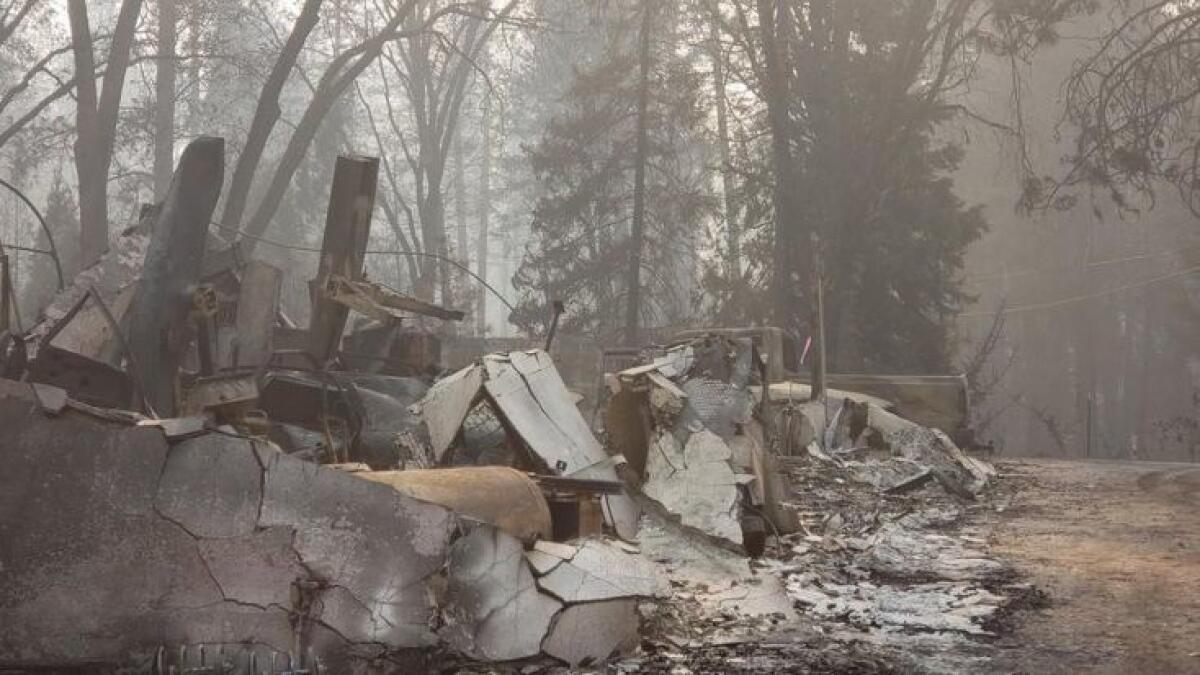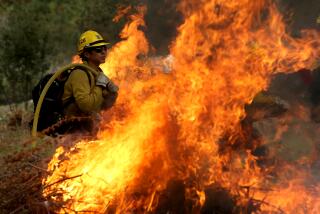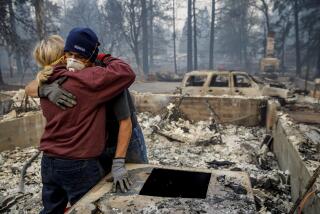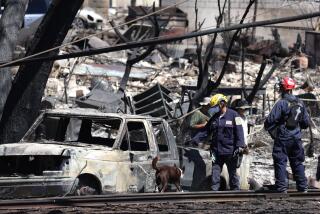These ashes have a story to tell: Building assessment teams examine the devastation of the Camp fire

The survivors of the Camp fire aren’t the only ones with a story to tell about the fire that destroyed Paradise.
Buried among the charred ponderosa pines and scorched rubble are clues to what transpired when a small fire broke out nearby on the morning of Nov. 8 and swallowed the California town of nearly 27,000 residents in a matter of hours.
While thousands of firefighters continue to battle the Butte County blaze, and as hundreds of personnel search for human remains, it’s up to a few dozen California Department of Forestry and Fire Protection investigators to read what the forest — and the rubble of buildings — has to tell them about the Camp fire’s destruction.
The story is of keen interest to Jeff Hakala, a fire captain who was a firefighter for 20 years with Cal Fire before switching over to the agency’s prevention side. Hakala, who focuses on land-use planning, had also spent part of his firefighter training at Fire Station 35 in Paradise, about a mile down the road, in the 1990s.
He was at the wine country fires in October 2017, the Thomas fire in December and both the Carr and Mendocino Complex fires this past summer. Recently, he spent the afternoon surveying the damage to properties off Skyway, west of Clark Road in Paradise.
“I see the areas [where] I used to go shopping and be a part of,” Hakala said. “I kind of knew this area.”
Wearing yellow turnout gear, thick boots and a helmet, Hakala circled the cinder block walls that hid the gutted interior of a two-story home.
He leaned down and picked up a piece of broken glass. It fit like a puzzle piece with the other shards that lay around it flat on the ground, still recognizable as the shape of a window.
The glass didn’t look thick to the untrained eye, but to Hakala, it was. If it had been a dual-paned window, it would have been thinner and possibly had a filmy sheen from the argon gas used to maximize thermal efficiency. Single-pane windows can crack and shatter in extreme heat and even when they don’t, the radiant heat from a fire can be so intense it will ignite furniture and curtains inside a home. Dual-paned windows are designed to mitigate those risks.
He pointed to the square opening the glass had fallen from. The top held metal framing — another telltale sign of a single-pane window, he said.
Near to the glass -- beneath dirt, ash, debris and twisted metal — he pointed to a piece of pebble-skinned material that blended in with everything around it but bore significance to him.
“This is composition shingles, because it’s kind of rough like that,” he said, running his index finger over the top. “If it was tile … it’d be in the body of the structure.” Composite shingles are supposed to be more fire resistant than wood shake or shingled roofs where embers can burrow in, smolder and eventually ignite the home. Tile roofs are also fire resistant, but depending on their design, can leave room for animals to build nests, which are extremely flammable.
Every detail — including the shape and material of a home’s eaves, the size of its vents and the types of windows and walls it’s framed in — will be added into an ever-growing database Cal Fire is building about Paradise.
“All that data is ultimately going toward finding out why homes are burning down,” Hakala said.

The job is simple but painstaking.
The damage assessors divided Butte County’s burnt ridges into zones and smaller divisions. They use parcel maps to determine where properties are supposed to be, then go lot to lot on foot and circle what’s left of the building. They make notes on an app on their cellphone.
One damage assessor said he can survey 60 to 100 properties in a day, depending on the density of the area and complexity of the scene.
More than 12,000 buildings were destroyed in the 146,000-acre Camp fire, with at least 9,700 of those being single-family homes like the one Hakala was inspecting on Friday. The entire area will eventually be searched, he said. All of that information is transmitted back to headquarters, where it’s compiled and ultimately used to create the map the public sees online that shows which homes were destroyed, sustained major or minor damage or came out of the blaze unscathed.
The Camp fire, Hakala said, is the worst fire he’s seen in his career.
“[It’s] the damage and destruction,” he said. “I was at Carr — that was devastating this year — I was at Napa, I was at Thomas, I was at the Mendo, and all of those fires had their own genuine feel. But this one in particular is pretty catastrophic. The intensity it came through at … someone mentioned it was eight football fields a minute. That’s crazy.”
Inspectors not only note if the buildings are residential or commercial, but how close they are to vegetation, propane tanks and any other structures.
Every piece fits into the larger conversation about homes in the wild land-urban interface.
He kicked a rock by the front door of a home, and its face fractured and fell to the ground like pieces of slate tile, indicating the heat was so intense that the face of the rock became brittle.
About 60 feet away, near where the land begins to slope and form the shoulder of a ridge, he pointed out branches halfway up a tree. All the leaves were cooked, intact and pointing the exact same direction, southwest toward the slope.
It’s what firefighters call a “foliage freeze,” when wind from the firestorm causes green vegetation to point in a singular direction and the searing heat dries and “freezes” it in place.
All around the home, signs of why it burned emerged.
It was surrounded by conifers, Hakala said. Without a doubt, that roof had a layer of dried needles resting on top, perfect kindling to put fire directly onto the home.
“Other than direct flame impingement, it’s more about where the embers are landing,” Hakala said.
Even the most fire-resistant building can be felled by one weakness in the armor. Or, in contrast, by sheer luck they can remain standing.
Down the road from where Hakala was working, two homes in a wide clearing of brush — one with modern construction, the other older — were undamaged. Yet other homes nearby with equally cleared land were completely destroyed.
A common thread among all the destroyed homes has yet to reveal itself, Hakala said. There are more data to crunch.
All investigators know is that much of the damage was caused by flying embers hopping from home to home, starting fires that created more embers to start more fires.
“I’ve learned that basically fire departments are having a hard time fighting the fires. There’s nothing that could’ve been done here except for saving people’s lives and get people out, which was the main goal,” Hakala said. “When you have a fire of this magnitude there’s little you can do from the suppression side to fight that fire. You just get people out.”
More to Read
Start your day right
Sign up for Essential California for news, features and recommendations from the L.A. Times and beyond in your inbox six days a week.
You may occasionally receive promotional content from the Los Angeles Times.







